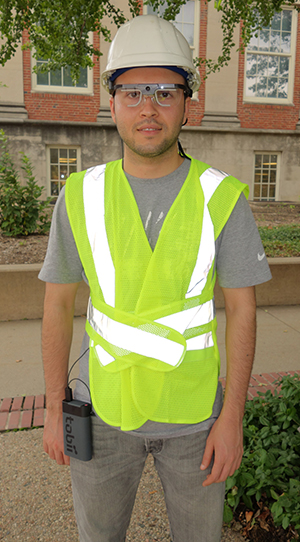Researchers in the US have used eye-tracking technology to measure the situational awareness of construction workers to understand the causes of human error on the job.
The University of Nebraska-Lincoln’s department of psychology and the vision, attention, memory and perception (VAMP) lab, in collaboration with the SARMAD Research Group, hope the insights obtained can be used to better help workers identify and prevent potential accidents.
Human error is one of the main factors in up to 80% of all occupational accidents. Behind these accidents is the lack of situational awareness – an inability to recognise the critical signs in one’s surrounding environment that may lead to danger.
An important property that affects situational awareness is the limited capacity of a person’s attention. Effectively allocating attention to maintain higher situational awareness plays a key role in detecting hazards and avoiding potential accidents.

Eye-tracking glasses were supplied by Tobli Pro
Because eye movements play a huge part in processing attention, the researchers employed eye trackers to objectively study the role of cognitive failure (ie inattentiveness) in accidents.
“Eye tracking lets you see the workplace through the worker’s point of view,” said Tom Englund, president of Tobii Pro, a leading provider of eye-tracking technology and research which supplied the eye trackers for this study.
“We can understand the rationale why certain things get noticed while other things are ignored, even if the worker being eye tracked isn’t fully aware of this mental process,” he added. “Armed with this insight, it’s possible to remove items in in the environment that lead to mistakes, or train workers on how best to notice these things on their own.”
In this study the researchers, led by Dr Behzad Esmaeili and also comprising Dr Michael D Dodd and Sogand Hasanzadeh, equipped 14 participants with the Tobii Pro eye-tracking glasses. They were told to navigate a real-world construction site and perform several tasks, all while being exposed to various controlled safety hazards.
The glasses captured live gaze data showing exactly where the workers were looking and how they experienced their surroundings. The data gathered presented a clear picture of what goes into being a “safe worker” and how they went about distributing their attention in a measured and focused way.
“The study provided a wealth of information about situational awareness as it relates to real-world construction sites,” said Esmaeili, who is now with George Mason University. “It proved the validity of using eye tracking to evaluate on the job safety.
“Construction companies can rely on the technology to detect at-risk workers with low situational awareness, eliminate unattended hazards on construction sites, and create best practices for training workers on how to be more alert on the job.”
A video on the study can be viewed here.











